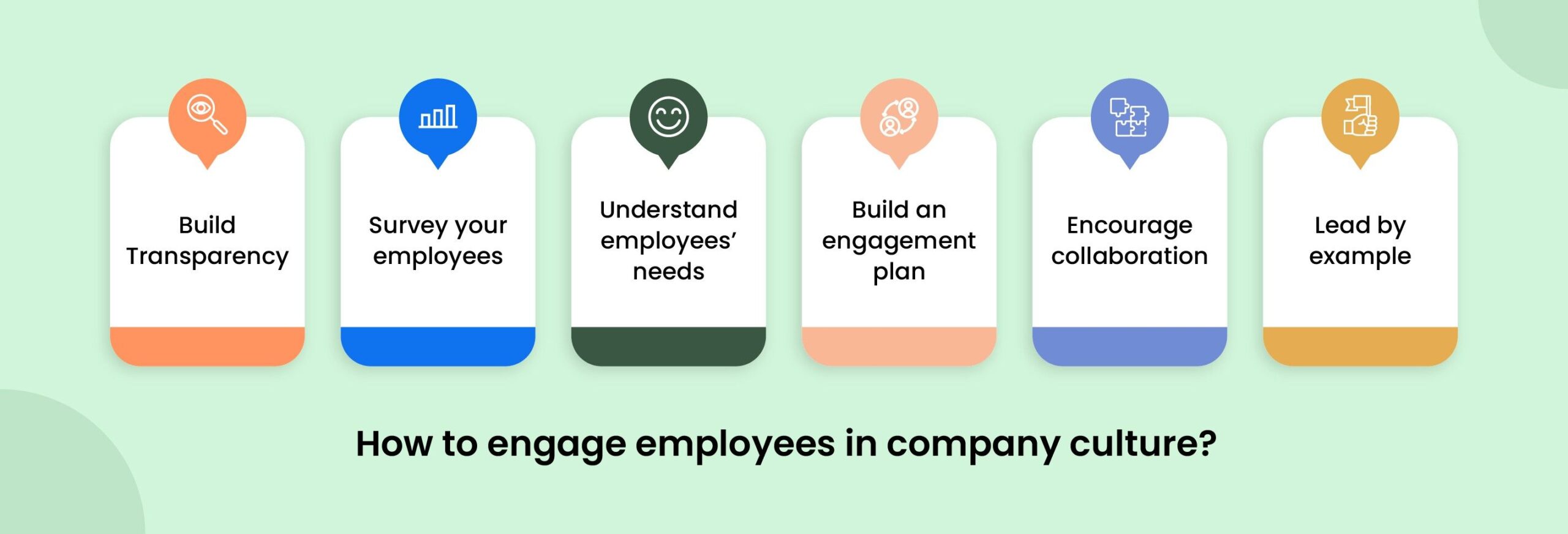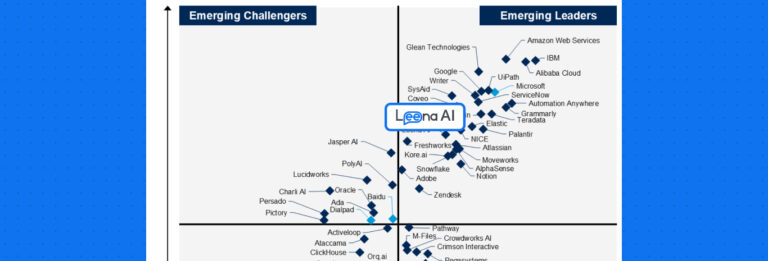Owing to the changing work environment, various leading organizations have shifted focus to two crucial aspects — company culture and employee engagement. In fact, they have gone from just being the HR’s responsibility to now being owned by the organization as a whole. But how do you define both of these terms?

Company culture is defined as the set of policies, practices, and behaviors that determine why and how things get done in the organization. In other words, it describes the way people behave within the workplace or what kind of behavior an organization expects from employees.
Employee engagement is the attachment and commitment that an employee feels towards their organization. It is defined as the extent to which employees are passionate about their jobs which determines the efforts they put into achieving company goals.
Company culture and employee engagement are directly related to one another. At the centre of both, lies the employees – the most important assets of an organization. Employee engagement helps empower a high-performing organizational culture by defining what is expected of employees. And once the employees understand the culture, they understand their role in it and how to make it better through their performance and actions.
Furthermore, when employees participate actively, not only, in their job roles, but also in other activities associated with the organization, they feel involved and productive — resulting in low employee attrition and a happy and satisfied workforce.
That’s exactly why there’s a need to adopt a healthy company culture to boost employee engagement. In this blog, we’re going to look into how company culture and employee engagement work hand-in-hand.
With millions of employees leaving their jobs due to being undervalued and underappreciated at their work, HR teams and leaders had to build their company culture from scratch. This includes their performance and their daily struggles that seemingly may not have much to do with their scope of work but affects it. Mental or physical health issues, situations at home, and other external factors all contribute to one’s level of attentiveness and productivity. Thus, ensuring that companies provide a comfortable and open environment free of toxic hierarchy is the key to retaining employees and keeping them content.”
Agnieszka Goulin
How does company culture affect employee engagement?
Company culture and employee engagement are the two most vital challenges in any organization. To boost engagement, it’s best to first work on improving the organizational culture.
Organizational culture affects employee engagement every single day. In fact, a survey by glassdoor shows that a company’s culture and values are the largest deciding factor for employee satisfaction. This shows how engaged and satisfied an employee is in the company depending on how they feel about the culture.
For example, suppose your company has a rigid structure where employees can communicate only with their direct managers via emails. In such scenarios, organizations experience high employee attrition rates, low productivity, and increased internal disconnects— ultimately decreasing the employee engagement levels and leading to employee disengagement. On the other hand, organizations that have open-door policies, easy accessibility, and an open culture are far more likely to have happy, productive and engaged employees.
Here’s how the company culture can affect employee engagement:

1) Communication
Communication plays a crucial role in building a robust company culture. When your employees feel more comfortable and safe while providing their feedback and voicing their opinions, they are more likely to speak up and provide valuable suggestions instead of letting resentments boil beneath the surface.
HR professionals must also respect all employees by listening to their ideas and making them feel heard. Hence, a culture that promotes open communication results in increased involvement and engagement of employees in company matters.
2) Safety
Safety at the workplace is another crucial factor that affects employee engagement. Employees who feel unsafe at work are likely to be disengaged. Lack of job security, mental or physical harassment, or increased risk of injuries are a few things that can discourage them from performing their best. Therefore, having a safe company culture is a must to keep tabs on employee behavior and eliminate these issues so the employees can focus on their work and boost their engagement and motivation levels.
3) Growth opportunities
Employees are more attracted to companies that provide growth and development opportunities to their workers. A company culture that offers opportunities for job promotion, career development, career growth, monetary benefits, upskilling, internal mobility, etc., has a highly engaged workforce who are unlikely to leave their jobs. They see the potential that they can achieve in the organization and wish to stay and work for them.
4) Decision-making
When a company has a well-defined mission, vision, and corporate values, it enables employees to make decisions effectively. It provides them with adequate information, references, and answers to questions that can help them during the decision-making process. It helps in keeping employees engaged and aligns them with the company goals.
How to engage employees in company culture?

 1) Build transparency
1) Build transparency
Workplace transparency involves sharing crucial information with your employees, no matter how challenging it might be. You can do this by either sharing company metrics, addressing an issue openly with team members, being honest in communicating differences or promoting trust within your team. Transparency helps employees feel connected to their companies and provide them with a sense of security. This helps them keep more focused on improving their performance and less stressed about their survival in the organization.
Furthermore, a survey by Forbes suggests that a transparent organization helps employees facilitate better ideas. If you are transparent with your employees, it will be much easier to get to know one another, build trust, and make teamwork more efficient since you will be getting support from other teammates. This trust can gradually turn into employee engagement, making workers feel more motivated and satisfied at work.
 2) Survey your employees
2) Survey your employees
Organizations must be aware of the engagement levels of each employee and the reason for their disengagement. This is where employee engagement surveys can help.
An employee engagement survey is an excellent tool to gather feedback from employees quickly and anonymously. You can use the results to make changes that positively impact company culture and employee engagement. In short, these surveys provide vital employee information that benefits the organization and employees. For example, you will:
- Uncover employee strengths and weaknesses;
- Understand the reasons for their disengagement or low motivation at work;
- Make employees feel heard and valued in the company;
- Get ideas from employees to boost their engagement, which you may never think of.
 3) Prioritize empathy
3) Prioritize empathy
Another powerful way to engage employees in company culture is to understand the needs of employees — what makes them happy, what they prefer, and so on. Leveraging “empathy” in your organization can help understand how employees feel about working in the organization. Plus, it makes people a part of the organization and helps them build strong relationships with their peers, managers and direct reports.
Furthermore, a culture of empathy will help you understand the different needs of employees. So, make sure to understand your employees on a personal and professional level. Learn about their likes and dislikes, what motivates them, and their strengths and weaknesses to create customized engagement-boosting strategies.
 4) Build an engagement plan
4) Build an engagement plan
An employee engagement plan is a system that companies develop to define and prioritize their employee engagement-related actions. These can be activities like rewards and recognition, development initiatives, team-building activities, surveys, employee engagement tools, etc.
With a robust engagement plan, you can identify critical factors that impact employee engagement, understand the struggles of the entire workforce, and create personalized strategies to address them. Furthermore, such plans help convey to employees that the organization is committed to listening and responding to employee engagement feedback. Hence, an employee engagement plan is an excellent investment to get started with, for increasing employee engagement levels.
However, before you start looking for the latest employee engagement trends, make sure you understand the program’s objectives, purpose, priorities, and desired result, and how it aligns with your company’s goals.
 5) Encourage collaboration
5) Encourage collaboration
Collaboration means working together to get things done. In other words, a collaborative work culture involves achieving the goals together, ensuring all team members contribute to the company’s success. Not only does it boost productivity, but it also promotes open communication among employees from different departments, interests, and backgrounds — leading to innovation.
Therefore, companies must strive to encourage collaboration within the workplace to promote a highly-engaged workforce. A culture of collaboration facilitates sharing of knowledge and promotes a sense of ownership where employees feel responsible for performing a part of their job and achieving the company’s success. It also instills a sense of belongingness in employees.
In short, fostering the right collaborative environment helps your employees establish and sustain strong relationships and become highly engaged, motivated, and proactive at their jobs.
 6) Lead by example
6) Lead by example
Employees are likely to trust and follow their managers that actively step up and demonstrate to their mentees how a particular task is done. Moreover, there is a stronger connection in the organization when managers believe in their employees.
To sum it up, it is crucial to be a benchmark example for your employees — someone who spends time promoting the culture and values of the organization. This way, every employee will look up to you not only to celebrate their success but also to embrace their failure and move forward.
Leena AI: The easiest solution to integrate employee engagement into your company culture
Company culture and employee engagement are tied together. No matter how great your company vision, mission, or culture is, it will be impossible to achieve your goals and success without engaging your employees.
Hence, your company needs to regularly invest in building a structured, transparent, and progressive company culture to build a high-performing and engaged workforce. But to make that happen at scale, the first step is to leverage technology for employee engagement and be a pioneer in creating a culture that delights employees.
Leena AI, with its power of artificial intelligence and NLP, creates an interactive experience at all touch-points of the employee lifecycle. It helps businesses lead their employee engagement efforts based on personalized data, maintaining a happy workforce and creating a dynamic culture that motivates the organization as a whole.
With Leena AI, you get an all-in-one tool that empowers you to:
1) Collect employee survey feedback
– Surveys that are integrated with all the platforms of your choice: Slack, Whatsapp, Teams, Outlook, etc.
– A chatbot to guide you through the interactive surveys in a language of your choice.
– Automated reminders sent to your employees to ensure maximum participation.
2) Analyze the mood of your organization
– Real-time dashboards and intelligent metrics for HR teams to work on.
– Get a glimpse of
-Employee Mood Scores: Are employees happy!?
-Employee Mood Trends: Changes in mood scores, what led to the drop or increase.
-Engagement Driver’s Scores: Individual score of engagement drivers – management, communication, growth opportunities, culture and many other parameters.
-Sentiment Analysis: Automated view of topics that employees are talking about in open-ended conversations.
3) Plan actions
– Plan actions, define and allocate responsibilities, map engagement metrics to business KPIs and track progress within the same tool.







2 Comments